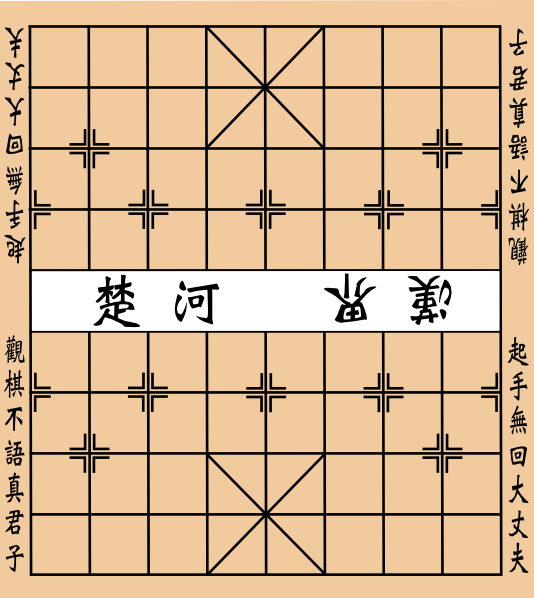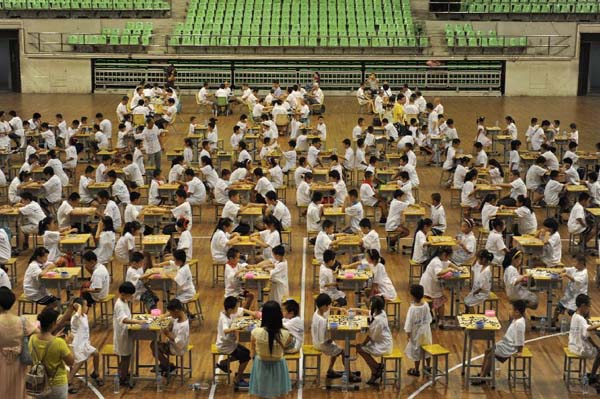The latest interest I've taken in my quest to learn more about my Vietnamese heritage is the game of Chinese chess. It is a bit ironic to look for Vietnamese culture in a game that has the word "Chinese" in its name, but I found that it is only so for the sake of translation. I have taken to this game for a number of reasons.
1. The game has cool historical references that have survived even today.
Let's start with the board itself. Unlike a chess board, which is played on the squares, Chinese chess is played on the intersections of lines.

What is most recognizably different from normal chess boards, however, is the large gap in the middle of the board as well as the lines that form an "x" on opposites sides of the board. The square that contains the "x" is known as the "fortress," or 宮(gōng) in Chinese. The center divider is the river where some Chinese words are visible. The words on the left say, 楚河 (chǔ hé), meaning "Chu River", and on the right, 漢界 (hàn jiè), meaning "Han border." This is a reference to the Chu-Han Contention that took place from 206 BC - 202 BC when the reign of power in ancient China shifted from the Qin Dynasty to the Han Dynasty. Many of the Chinese chess boards that are made today still include this reference.
 |
| And how troops used to cross the Chu River is something that will forever befuddle me. |
2. The pieces in Chinese chess are more interesting than those in international chess.
As this picture shows, there are a number of pieces that are similar with chess, namely the pawn, knight, rook, and of course the king (not pictured). They function quite similarly in behavior and strategy, but with modified or weakened powers. The two pieces unique to Chinese chess are the elephant and the cannon. The elephant is primarily a defensive piece, but it's still cool to think that each player's army includes war elephants. The other (and personally, my favorite) piece is the cannon. The cannon is like the rook from Western chess, but in order to capture another piece the cannon must have a "screen" between it and the piece it wants to capture. This essentially makes it a "flying" cannon, and about the coolest thing to imagine when playing.
 |
| Go ahead. Try and tell me you don't think this is terrifying. |
With regard to the historical references again, you'll notice that the piece for both sides are represented by slightly or completely different Chinese characters. That is because the characters for the pieces on the red side are considered more "royal," and thus represent the "good" side. Some people believe that this practice may have actually originated in situations where there was only one material available to make the pieces from and no coloring material available to distinguish the opposing armies. Still, I like to think that one side is playing the "good guys" and the other the "bad guys."
3. The game is rooted in Vietnamese culture.
Unfortunately, I can't offer a complete explanation for the ties between Vietnamese culture and Chinese chess, but there are certainly many things that I have observed. Firstly, the game is extremely popular in Vietnam. Young kids learn to play as part of their school curriculum, and others (typically men, from what I've seen) can be seen playing that game at cafes, on the side of the street, or at tournament-like gatherings.
 |
| The training grounds for Vietnam's next war leaders. |
Around Tết, it is apparently tradition in some villages to play human Chinese chess. There are such rules as the person playing the general must come from a wealthier family (because they have to provide food for the other players) and one side consists of only boys and the other of only girls. Another cool thing they do during these events is have the "pieces" perform acts of martial arts as they move around the board.
 |
| Surprisingly, they also "fight" when another piece is attacked and captured. |
Another funny thing that I've noticed is that a lot of the plastic tables here come with Chinese chess boards molded onto them. I don't know if they ever get used to actually play the game, but it certainly speaks to the game's ubiquity.
That's all for now, but before I go, here is my obligatory me-playing-the-game picture. Credit to Nhat Nguyen for taking the photo and sprucing it up.


Comments
Post a Comment